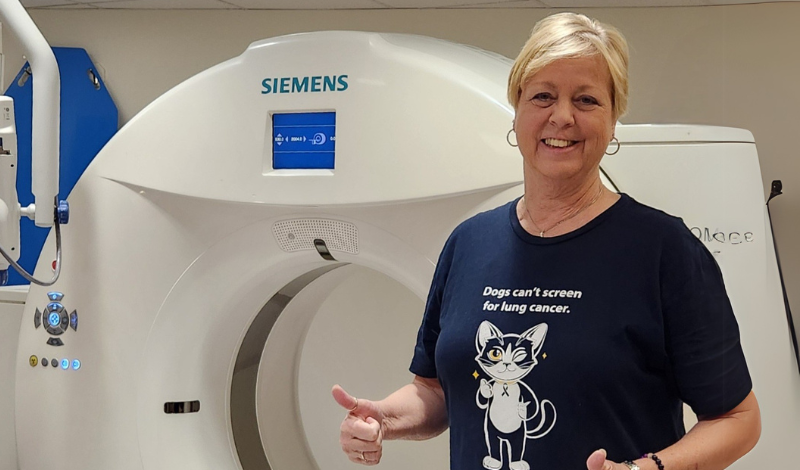
It doesn’t matter why or how someone develops lung cancer—what matters most is early diagnosis and prompt treatment. Wendy Brooks’ inspiring journey shows how regular lung cancer screening saved her life, transforming what could have been a devastating diagnosis into a story of hope and survival.
Multiple Risk Factors: Understanding Lung Cancer’s Complex Origins
For most of her career, Wendy Brooks worked for the Department of Transportation in St. Louis, Missouri. Most of her work hours were in quarries, working with concrete and asphalt production and, as a result, being exposed to silica dust and other minerals. The house she grew up in tested positive for radon. Her father had also been a smoker. Ten years before her diagnosis, Wendy had lost her father to Non-Small-Cell Lung Cancer (NSCLC). And, she, along with her husband, with whom she worked, was also a smoker.
With so many possible contributing factors—occupational exposure, radon, family history, and personal smoking history—it is impossible to determine what “caused” her cancer. This reality underscores an important truth about lung cancer: multiple risk factors often overlap, and prevention requires addressing all possible exposures.
The Life-Saving Power of Regular Screening
Wendy was fortunate to have a primary care physician who strongly encouraged her to undergo annual low-dose lung cancer screening CT scans beginning in 2018. For five consecutive years, these screenings showed no signs of cancer—demonstrating the importance of consistent monitoring even when results appear normal.
In March 2023, something showed up. She was told to “not lose sleep over it…we’ll do another scan in 3 months.” Three months later, Wendy got the call: the mass had grown, it was suspicious, and a biopsy was necessary. Within a week, she underwent a lung biopsy, which was unsuccessful. Wendy had been given a twilight anesthesia and awoke during the procedure, which resulted in the doctors obtaining too small a sample to be conclusive. Later that same week, she had a second biopsy and bronchoscopy. After two biopsy attempts (the first being inconclusive), Wendy received her diagnosis: Small Cell Lung Cancer (SCLC), a less common but typically more aggressive form of lung cancer that historically has been more challenging to treat than Non-Small Cell Lung Cancer.
From Detection to Treatment: Moving Quickly After Diagnosis
Following her diagnosis, Wendy’s medical journey accelerated rapidly. She underwent a comprehensive series of tests – a PET scan, an MRI, and a pulmonary lung function test – before meeting with her oncology team. At that initial meeting, the doctors agreed with the diagnosis. Wendy was very worried, but from the get-go, had an amazing attitude. She told her doctors:
“I am a unicorn. I am going to beat this.”
Their response was equally powerful:
“You don’t need any magical powers. We are treating to cure.”
Despite her strength and positive outlook, the diagnosis was a crushing blow, particularly after her father’s diagnosis and outcome. Yet Wendy tackled it head-on as she underwent four rounds of chemotherapy and 30 doses of chest radiation. The oncology team also suggested preventative cranial radiation, but Wendy decided against it, given the fact that SCLC was evident only in her left lung and one adjacent lymph node. Moments after the plan was in place, Wendy walked across the hall and had her first infusion.
The Crucial Role of Support During Lung Cancer Treatment
Navigating lung cancer, treatment plans, and side effects is an arduous undertaking. Wendy’s stepdaughter is a Physician’s Assistant in psychiatric oncology. As such, she knew what to ask, what to expect, what was to come, and who to include on her medical team. Her expertise and support were priceless to Wendy:
“She was such an incredible guide. She was able to emotionally remove herself from the situation and explain the medical information that was coming at me. She supported me in a way that I will forever be grateful for.”
Living Life Despite Cancer: Finding Joy During Treatment
On September 30, 2023, Wendy had completed her initial treatments—just in time for a previously planned family vacation to the Albuquerque Balloon Festival. She was fatigued and struggled a bit with esophagitis from the radiation, but the pain with swallowing was not enough to prevent her from a wonderful trip full of special moments and memories.
Upon her return home, it was soon time for Wendy to have her scans. While she was not declared NED (no evidence of disease), everything was stable, including her brain, which remained clear. She continued to have scans every three months (as is standard protocol).
Adapting to New Challenges: When Cancer Progresses
In January 2024, just six months after her initial diagnosis, Wendy had developed a 2-3-centimeter brain metastasis. Although she had no symptoms, her medical team felt it was necessary to warrant Gamma Knife surgery, a procedure that uses very precise beams of gamma rays to treat a lesion or lesions in the brain.
Days before her scheduled Gamma surgery, Wendy suddenly found her left arm moving spastically: “like a chicken flapping their wing”. Fortunately, this occurred just moments before a virtual visit with her neurosurgeon, who explained to her that what she had experienced was a seizure. Similar seizures would happen daily until her surgery. These seizures would also do a number on her rotator cuff and displace the tendon from her shoulder to her bicep, pulling it right out of its slot. Following treatment and the resultant shrinking of the tumor, the pain did subside.
By March, while her brain scans looked promising, her lung tumor had grown significantly. Unwilling to return to standard chemotherapy, Wendy advocated for herself: “I wanted great medicine. I pushed for new medications and clinical trials.”
Breakthrough Treatments: Pioneering Therapies for Small Cell Lung Cancer
Though unable to secure the clinical trial spot she requested, Wendy did land another study therapy. An antibody-conjugate chemotherapy, targeted therapy previously uncommon for SCLC. “Doctors likened it to a Trojan Horse that seeks out the protein, attaches to it, and sends the medicine directly to the types of cells with that protein expression,” she explains.
This innovative approach reduced her tumor size by 65%. But there was also a volume increase. A follow-up PET scan in January 2025 showed that the disease was not spreading, but because Wendy had tested positive for Delta-like ligand 3 (DLL3), the doctors were not ready to cease treatment. Instead, they pivoted to another clinical trial using BiTE (Bi specific T-cell engager) immunotherapy – another first in SCLC treatment – which was delivered via injection (as opposed to intravenously) every three weeks. The most recent scans show a 50% reduction in tumor and a 72% reduction in volume. Wendy remains on this course of treatment today.
Finding Gratitude After Lung Cancer Diagnosis
When asked how she is feeling, Wendy enthusiastically says, “Fantastic!”
“A diagnosis like this makes you appreciate every day so much more. There is a point in time when you think you are never going to die. As you get older, you understand that, indeed, you are going to die, but you don’t dwell on it. Then you get hit with a diagnosis, and you have to work hard to get back to the point that you don’t dwell. Life is fragile and a blessing – make plans, have goals, and hope for tomorrow, but live for today. No one is guaranteed tomorrow.”
Wendy emphasizes the importance of her support system:
“No story about my cancer journey would be complete without noting that I know how fortunate I am. My husband, our children and our three grandsons have been my rocks. I could never have found this strength without them.”
The Message: Lung Cancer Screening Saves Lives
Wendy’s story powerfully illustrates how lung cancer screening can make the difference between life and death. Her early diagnosis—made possible only through regular screening—allowed for prompt treatment with cutting-edge therapies, giving her precious time with her loved ones and a fighting chance against this aggressive disease.
If you or someone you love has risk factors for lung cancer, talk to your doctor about whether lung cancer screening is appropriate. As Wendy’s experience shows, these simple scans can truly save lives.
I’m using my lungs to advocate
As a member of LCFA’s Speakers Bureau, I’m advocating for research and raising awareness through the media, embodying hope and action.
View Speaker Profile
